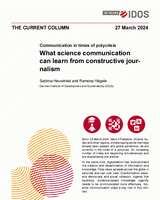Communication in times of polycrisis
What science communication can learn from constructive journalism
Heuwinkel, Sabrina / Ramona HägeleThe Current Column (2024)
Bonn: German Institute of Development and Sustainability (IDOS), The Current Column of 27 March 2024
Bonn, 25 March 2024. Wars in Palestine, Ukraine, Sudan and other regions, climate tipping points that have already been passed, and global pandemics: we are currently in the midst of a polycrisis. An increasing number of crises are happening simultaneously and are exacerbating one another.
At the same time, digitalisation has revolutionised the creation and dissemination of information and knowledge. Fake news spreads across the globe in seconds and can cost lives. Disinformation weakens democracy and social cohesion. Against this backdrop, evidence-based knowledge urgently needs to be communicated more effectively. Science communication plays a key role in this context.
Overload on all levels
The neuroscientist and co-founder of Perspective Daily, Maren Urner, says that there is an ‘overload on all levels‘ and that fake news and modern digital communication put excessive strain on recipients. The fact that negative content attracts more attention and generates more clicks leads to an over-representation of bad news in the media. As a result, in view of the many problems presented in the media, recipients gain the impression that the situation is hopeless. There is a risk of a feeling of helplessness being perpetuated, with people actively choosing to avoid news reports. Yet the opposite is necessary if we are to achieve environmental transformation and a sustainable future: we need activity and involvement instead of passiveness and disinterest.
The concept of constructive journalism
Science communication reflects what the scientific community is producing and integrates it into social discourse. The idea behind constructive journalism is not only to describe a problem but also to look at what happens next. The Bonn Institute describes constructive journalism on the basis of three elements: a pronounced focus on solutions; multiple perspectives, including diversity and structural aspects; and a constructive dialogue, in which journalists also act as moderators, advocating exchange and understanding.
Science communication needs to be continually refined
In view of the considerable challenges, science communication is of major significance. Constructive journalism can provide key impetus in this context. Constructive approaches can already be included when communication concepts are being devised. Simplification is essential in science communication, but complexity also needs to be communicated. Carefully curated science-based tools and portals (e.g. Kurzgesagt – In a Nutshell, Scholars Strategy Network, The Conversation) show how this is done. In principle, more resources should be invested in creative approaches to designing communication, such as podcasts, infographics, animations and explainer videos. This is the only way to ensure that evidence-based scientific content stands a chance in the ruthless competition for attention on social media platforms. AI-based tools will provide important support here. AI applications can quickly and easily transform long texts into ‘snack content’ suitable for social media, translate content into many different languages, and convert and make texts available as audio content.
Creating spaces for constructive dialogue
Science communication can open up spaces for dialogue to share possible solutions, it can initiate constructive debate and it can enter into dialogue with social groups and stakeholders by making evidence-based research results available, discussing not only what sustainable and just futures might look like but also what is already working well. Science communication that sets out to follow the example of constructive journalism and, in times of polycrisis, also communicates with a focus on target groups on the large platforms makes a necessary contribution to promoting social cohesion, safeguarding democracy and achieving the 2030 Agenda.
This column and a video series of ‘Synergetic stories on sustainability and digitalisation in the Amazon region’, based on the principles of constructive journalism, were produced as part of an EU Horizon 2020 project co-financed by the European Union titled PRODIGEES – Promoting Research on Digitalisation in Emerging Powers and Europe Towards Sustainable Development (873119-PRODIGEESH2020-MSCA-RISE-2019). Link to the video series on YouTube: https://lmy.de/hWWi


